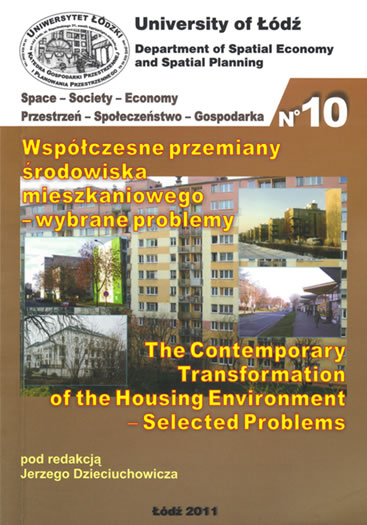OSIEDLA GRODZONE W ŁODZI. PRZYCZYNY I KONSEKWENCJE ZJAWISKA
DOI:
https://doi.org/10.18778/1733-3180.10.05Abstrakt
Gated communities appeared in Poland at the beginning of the 1990s and since then they have played an important role in the social landscape of Polish cities, including Łódź. Although they are a global phenomenon, local socio-cultural conditions determine their final shape; in Poland these conditions are: the nobleman’s-peasant’s tradition as well as the recent political and economic transition. This research shows that the property developers’ offers presenting their recent investments emerge towards two basic needs of the real estate market clients: safety and peace. They also underline the prestige of living in gated communities which according to the literature on the subject is, apart from safety, the most important reason for “gating”. The offer is directed at the representatives of the metropolitan class which is now rising in Poland, i.e. young, well-educated, well-earning people whose needs cannot be satisfied by existing housing estates of the socialist era. Such an image of the residents of gated communities has been revealed from the opinions of people living in open housing estates located in their neighbourhoods. Both inhabitants of gated communities and their neighbours from “outside the gate” see the increase in the safety of housing estates and aesthetic values as the positive consequence of gated communities. The main negative consequence within public opinion is the influence of this phenomenon on social relations. This article outlines, on the example of Łódź, a clear boundary between the public and private space which appeared within modern Polish cities together with the gated communities phenomenon. Apart from the disintegration of space, there have been some negative processes within the social relations such as social divisions, conflicts and weakening social ties. One should bear in mind an alternative for gated communities flourishing in Polish cities; the alternative which could ensure the basic need of the safety of housing estates residents, as it is the main reason for “gating”. Urbanists, architects, all those who are responsible for the shape of urban space should prepare well for the debate on gated communities in Poland and be ready to convince the public opinion that they are not the only way to improve security and fulfill the expectations of their residents.
Pobrania
Bibliografia
Blakely E., Snyder M., 1997, Fortress America, Washington: Brookings Institution.
Google Scholar
Chabowski R., 2007, Kwestia klasyfikacji i nazewnictwa osiedli zamkniętych w Warszawie, [w:] Gettoizacja polskiej przestrzeni miejskiej, red. B. Jałowiecki, W. Łukowski, Wydawnictwo SWPS Academica, Wydawnictwo Naukowe Scholar, Warszawa.
Google Scholar
G decki J., 2007, „Za murami” − krytyczna analiza dyskursu na temat osiedli typu gated communities w Polsce, [w:] Gettoizacja polskiej przestrzeni miejskiej, red. B. Jałowiecki, W. Łukowski, Wydawnictwo SWPS Academica, Wydawnictwo Naukowe Scholar, Warszawa.
Google Scholar
G sior-Niemiec A., Glasze G., Putz R., Sinz D., 2007, Grodzenie miasta: casus Warszawy, „Studia Regionalne i Lokalne”, nr 4(30).
Google Scholar
Jałowiecki B., 2000, Społeczna przestrzeń metropolii, Wydawnictwo Naukowe Scholar, Warszawa.
Google Scholar
Jałowiecki B., 2007, Fragmentacja i prywatyzacja przestrzeni, [w:] Gettoizacja polskiej przestrzeni miejskiej, red. B. Jałowiecki, W. Łukowski, Wydawnictwo SWPS Academica, Wydawnictwo Naukowe Scholar, Warszawa.
Google Scholar
Karwińska A., 2008, Gospodarka przestrzenna. Uwarunkowania społeczno-kulturowe, Wydawnictwo Naukowe PWN, Warszawa.
Google Scholar
Low S., 2003, Behind the gates: life security and the pursuit of happiness in fortress America, London, Routledge.
Google Scholar
McKenzie E., 2003, Common-Interest Housing in the Communities of Tomorrow, ”Housing Policy Debate”, No 14. 1/2.
Google Scholar
DOI: https://doi.org/10.1080/10511482.2003.9521473
Michałowski L., 2007, Granice bezpieczeństwa, czyli krótka historia pewnego bloku, [w:] Gettoizacja polskiej przestrzeni miejskiej, red. B. Jałowiecki, W. Łukowski, Wydawnictwo SWPS Academica, Wydawnictwo Naukowe Scholar, Warszawa.
Google Scholar
Owczarek D. A., 2007, Życie społeczne zamkniętych osiedli warszawskich − czyli co się dzieje za bramą?, [w:] Gettoizacja polskiej przestrzeni miejskiej, red. B. Jałowiecki, W. Łukowski, Wydawnictwo SWPS Academica, Wydawnictwo Naukowe Scholar, Warszawa.
Google Scholar
Smith Bowers B., Manzi T., 2006, Private Security and Public Space: New Approaches to the Theory and Practice of Gated Communities, “European Journal of Spatial Development”, No 22.
Google Scholar
Zaborska K., 2007, Przestrzeń miejska – dobro wspólne czy ziemia niczyja?, [w:] Gettoizacja polskiej przestrzeni miejskiej, red. B. Jałowiecki, W. Łukowski, Wydawnictwo SWPS Academica, Wydawnictwo Naukowe Scholar, Warszawa.
Google Scholar
Pobrania
Opublikowane
Jak cytować
Numer
Dział
Licencja

Praca jest udostępniana na licencji Creative Commons Attribution-NonCommercial-NoDerivatives 3.0 Unported License.









